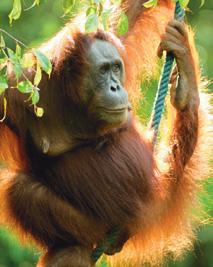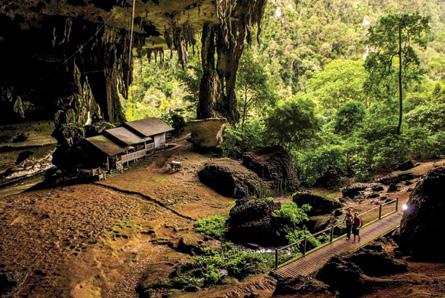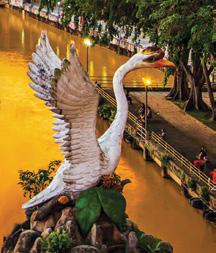
9 minute read
THE BIG 4
A look at Sarawak’s four major cities and towns and what makes each of them special
The largest State in all of Malaysia, Sarawak offers great diversities of culture, adventure, nature, food and festival. The State is so vast that you couldn’t possibly finish exploring it in a month even, assuming of course you’re planning to see all its key attractions within the month.
Advertisement
Sarawak has Kuching as its Capital City, which also happens to be the largest city in East Malaysia. Its three other major cities are Miri, Sibu and Bintulu, although the last two do not have an official city status yet. Let’s take a look at these four cities and towns of Sarawak and what makes them special. Maybe this ought to help you to better plan your trip to the Land of the Hornbills.
KUCHING
On Aug 18, 1842, Kuching came under the administration of James Brooke, a British adventurer who was appointed Governor of Sarawak on Sept 24, 1841 and given the title Rajah after helping Pengiran Raja Muda crush a rebellion in November of 1840. After surviving World War II, Kuching was revitalised as Sarawak’s capital under the British Colonial administration.
After Sarawak joined Singapore, North Borneo and Malaya to form Malaysia in 1963, Kuching remained the capital of the State of Sarawak. It was granted a city status on Aug 1, 1988 and has since enjoyed tremendous development while preserving its beautiful heritage. Kuching is also the first ever city in the world to be declared a “City of Unity” (declared on July 29, 2015).
So what makes Kuching special?
TWO MUNICIPALITIES: Kuching City is divided into two municipalities, namely Council of the City of Kuching South (MBKS) and Commission of the City of Kuching North (DBKU). We’d say that’s pretty unique.

City of Kuching South (MBKS)

City of Kuching North (DBKU)
CAT STATUES: With its nickname Cat City, it doesn’t come as a surprise that statues of cats can be seen in many key areas in the city. One of the most famous ones is the Cat Family monument installed by DBKU at Kuching’s Golden Triangle, between Grand Margherita Hotel and Riverside Majestic Hotel. The other famous one is the big white cat statue at the Padungan roundabout. The cat statue would be seen wearing festive costumes every time Hari Raya, Chinese New Year, Christmas or Gawai comes around.

Kuching is known for some of Sarawak’s most iconic modern-day structures that still retain some classic Sarawak features, making them truly stand out as far as architecture is concerned. These icons of modern-day Sarawak include the new State Legislative Assembly (DUN) building, the new Kuching Floating Mosque, the ‘S’-shaped Darul Hana Bridge and the crowd-pulling Darul Hana Fountain, all located within close proximity to each other at the scenic Kuching Waterfront.

Kuching Must-visits
Other must-visit places within and near Kuching City:

Semenggoh Nature Reserve

Sarawak Cultural Village
To experience Sarawak’s cultural diversity.

Top Spot Food Court
For some of the freshest seafood in town.
MIRI
The booming city of Miri was once an area dotted with fishing villages. Its name was derived from its earliest settlers, namely the Jatti Miriek. The Europeans who came here for oil exploration mispronounced the name Miriek as Miri, and the name has been used ever since.
Although the locals have been digging for oil for centuries in Miri, it wasn’t until 1910 that the oil and gas industry took off following the commencement of the first oil drilling operation at Canada Hill (then called Miri Hill) on Aug 10 of that year by Royal Dutch Shell. After drilling 130 metres into the oil well via a 30-metre-high oil rig now known as the Grand Old Lady, oil was struck on Dec 22 that same year. The rest, as they say, is history!
What’s interesting is that on May 20, 2005, Miri became the first non-state capital in Malaysia to be given an official “city” status, and the 10 th city in Malaysia to receive such status. However, Miri has been a municipality since Nov 6 of 1981.
What’s special about Miri?
PREHISTORY: If you haven’t already heard, evidence suggests that Niah Cave near Miri was once home to the earliest modern human in Southeast Asia. A Homo sapiens skull nicknamed Deep Skull was discovered there in 1958 by Tom Harrisson. Possibly belonging to a girl in her late teens, the skull dates back to 40,000 BC. Therefore, a visit to Niah Cave (110 km from Miri city) is an absolute must, especially if human prehistory interests you.


NATURAL WONDERS: Miri is definitely where you want to go to see Mother Nature’s proud display of her glorious spectacles. It is home to the wondrous caverns and the jaw-dropping Pinnacles in Mulu National Park, the captivating flushes of blue on the shores of Tusan Beach, from the bioluminescent algae called Dinoflagellates, and the surreal scene of Niah Caves’ bat exodus at sundown.

GIANT SEAHORSE: In Kuching, you get cat statues, in Miri, you get the seahorses. One that you cannot miss is the giant seahorse lighthouse at the famous Coco Cabana, at Miri’s Marina Bay. In fact, it is the largest seahorse sculpture in Malaysia, and is actually a lighthouse.

Miri Must-visits
Other must-visit places within and near Miri City:

Petroleum Museum
For history of Miri after the discovery of petroleum. The Grand Old Lady is the main attraction here.

Bario
To experience life in the Kelabit Highlands.

Jalan North Yu Seng
For Miri’s cluster of bars and nightclubs, as well as street food.
SIBU
What is now lovingly known as Swan City became a part of Sarawak in 1853, following the expansion of Sarawak by Sir James Brooke. First inhabited by the Melanau people, this town of over 200,000 people (including the suburbs) at present is now home to mostly Chinese folks of the Foochow sub-ethnic group, followed by the Iban, Melanau, Bidayuh and other indigenous tribes.
Following an agreement signed on Jul 9, 1900 between a Christian scholar from Fujian, China, Wong Nai Siong and the Brooke administration in Kuching, a total of 1,118 Foochow settlers arrived in Sibu between January and June of 1901. Sibu became their new home ever since.
Throughout history, Sibu endured among others the Japanese occupation and Communist insurgency until the Communist movement in Sarawak finally came to a halt in 1990.
Today, Sibu is a prosperous town located on the confluence of the Rajang and Igan rivers. Aspiring to be a city in the future, present-day Sibu is an ever-developing town most well-known for its offering of delicious food, world-class events and Wisma Sanyan, once the tallest building in Sarawak and is the venue for the Sibu International BASE Jump.
What’s unique about Sibu?
BOAT TERMINAL: The river still holds great significance to Sibu, and is still a preferred means of transport for some. That’s why Sibu’s Express Boat Terminal remains popular even to this day. What’s special about it are the express boats that are made out of old aeroplanes. It’s something you might want to experience when you visit Sibu.

MAMMOTH MARKET: Sibu has the largest indoor market in all of Malaysia, with more than 1,000 vendors selling anything from seafood, meat and poultry to jungle produce and handicrafts. The upper floors house a food court and stores selling apparels and accessories. The variety of products here is just mind-boggling.

MURALS GALORE: When it comes to murals, Sibu has loads! Street murals mostly depicting life in Sibu can be found in many nooks and crannies within the town centre itself. One of the popular ones depicts the Ding Bian Hu seller making the rice-based flat noodles and is painted on a wall just outside the actual Ding Bian Hu shop itself.

Sibu Must-visits
Other must-visit places within and near Sibu Town:

Bukit Lima Nature Reserve
To get close to nature.

Bawang Assan Longhouse
For a sneak peek into the lives of the Bawang Assan Iban longhouse community.

Rajang Esplanade
For a photo with the Swan statue, an icon of Sibu located at the end of the esplanade.
BINTULU
This coastal town in the Central Region of Sarawak derived its name from the words Mentu Ulau, a local native dialect for “picking heads”. When it was acquired in 1861 by James Brooke, it was still a small fishing village. Interesting to note is that the very first General Council meeting, which is now known as the State Legislative Assembly, took place in Bintulu in 1867.
Development took place in Bintulu following the discovery of large reserves of oil and gas off its shores in 1969. This opened up opportunities in Bintulu, which later became an industrial town and the gateway to the Samalaju Industrial Park. But while Bintulu is a town focussed on energy-intensive industries, the local administration Bintulu Development Authority (BDA) is currently pulling all the stops to make sure the town is as spotless as they can possibly make it – with help from the local residents of course. Today, Bintulu is a clean and beautiful town with its own set of attractions.
What makes Bintulu special?
CLEANLINESS: Thanks to BDA’s greening campaigns, Bintulu is today one of the cleanest towns in Sarawak. Go on a scenic drive from the town centre to the BDA office for example, and you will notice that the streets are almost completely spotless.

WILDLIFE ON SHOW: At Bintulu’s Taman Tumbina, you’re guaranteed an audience with some of the animal kingdom’s majestic birds and beasts, including the Rhinoceros Hornbill and the tiger. The park also teems with thousands of plant species.

SCENIC WALK: Bintulu is home to Sarawak’s longest waterfront. The Bintulu Promenade covers an area of over 120 acres and looks out to the South China Sea. It’s THE place in Bintulu from which to catch the sunrise in its utmost glory.

Bintulu Must-visits
Other must-visit places within and near Bintulu Town:

Similajau National Park
To see Bintulu’s wild side.

Kampung Jepak
To experience life in a fishing village and see how Bintulu’s famous belacan is made.

Council Negeri Memorial
A monument built to commemorate Sarawak’s first legislative assembly meeting.







